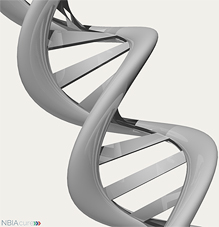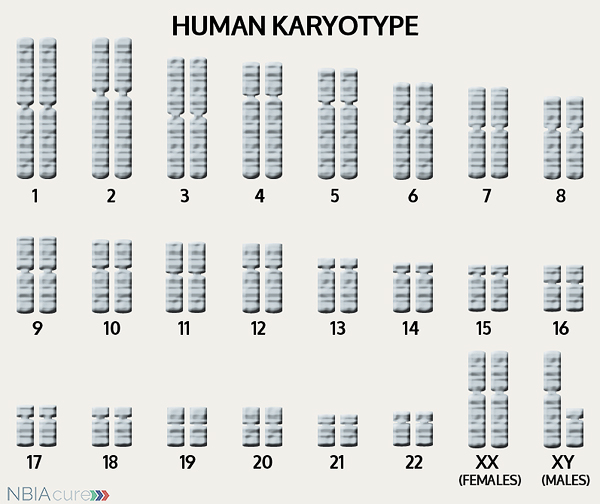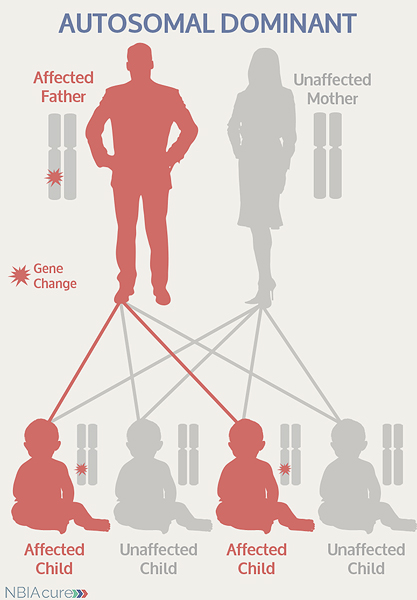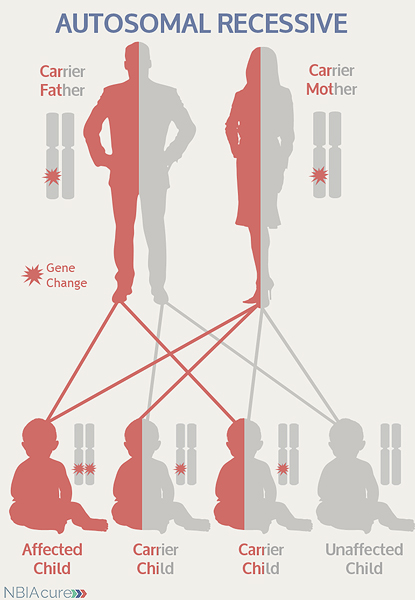 DNA
DNA
The human body is made up of millions of cells. Inside every cell there is a structure called DNA, which is like an instruction book. Just like you would use an instruction book to put together and operate a TV, DNA is used as an instruction book for your body. DNA contains detailed steps about how all the parts of the body are put together and how they work.

CHROMOSOMES
However, unlike an instruction book for something simple like a TV, the instruction book for the body contains much more information. Since DNA contains too much information to fit into a single “book”, it is packaged into multiple volumes called chromosomes. As seen in the picture to the right, humans typically have 46 total chromosomes that are organized in 23 pairs. There are two copies of each chromosome because we receive one set of 23 chromosomes from our biological mother and the other set of 23 from our biological father. Chromosomes 1-22 are called autosomes and the last pair is called the sex chromosomes because they determine a person’s gender. Females have two X chromosomes and males have one X and one Y.
 GENES
GENES
If DNA is the body’s instruction book and it is stored in multiple volumes (called chromosomes), then genes would be the individual chapters of those books. Genes are small pieces of DNA that regulate certain parts or functions of the body. Sometimes multiple genes are needed to control one function. Other times, just one gene can influence multiple functions.
Humans have 23 total pairs of chromosomes and each chromosome is made up of many genes. Therefore, since there are two copies of each chromosome, there are also two copies of each gene. In some gene pairs, both copies need to be expressed (or turned on) in order for them to do their job correctly. For other genes, only one copy needs to be expressed.
CHANGES IN GENES
When a single cell in the human body divides and replicates, its DNA is also replicated. This replication process is usually very efficient and accurate, but sometimes the body can make a mistake and create a “typo” (or gene change). Just like a typo in a book, a gene change in the DNA can be unnoticeable, harmless, or serious. A gene change with serious consequences can result in a part of the body not developing correctly or a particular function not working properly. For example, changes in certain genes cause a person to develop their particular NBIA disorder. Changes in these NBIA genes lead to the groups of symptoms we observe, although we do not yet understand how the changed genes cause many of these findings.
INHERITANCE
As mentioned earlier, humans have a total of 23 pairs of chromosomes. Half of these chromosomes are passed down (or inherited) from the biological mother and half from the biological father. There are three main patterns that we see when children inherit a genetic condition. These happen when a gene carrying a change is passed down from parents to child.
AUTOSOMAL DOMINANT INHERITANCE
“Autosomal” refers to the fact that the gene carrying a change is located on one of the autosomes (chromosome pairs 1-22). Since the sex chromosomes are not involved, that means that males and females are equally likely to inherit the changed gene. “Dominant” refers to the fact that having a change in just one of the two gene copies is all it takes for a person to express a trait.
 As seen in the image to the left, when one parent has a dominant gene change, there is a 50% chance that any child they have will inherit that change. Since the gene change is located in the autosome, the gender of the child (whether it is a son or daughter) does not affect this pattern. Girls and boys will be affected equally.
As seen in the image to the left, when one parent has a dominant gene change, there is a 50% chance that any child they have will inherit that change. Since the gene change is located in the autosome, the gender of the child (whether it is a son or daughter) does not affect this pattern. Girls and boys will be affected equally.
AUTOSOMAL RECESSIVE INHERITANCE
“Autosomal” refers to the fact that the gene carrying a change is located on one of the autosomes (chromosome pairs 1-22). Since the sex chromosomes are not involved, males and females are equally likely to inherit the changed gene. “Recessive” refers to the fact that a change must be present in both copies of a particular gene for the person to express a trait. Therefore, a copy of the gene change must be inherited from both the father and the mother. If an individual has only one recessive gene change, then they are called a “carrier” for that trait or disorder. Carriers do not have health problems related to that gene change and often do not know they carry a recessive gene change.
 However, if two carriers have a child together, then there is a 25% chance that they will both pass on their recessive gene changes and have a child with that trait or disorder. As seen in the image to the left, in a pregnancy between two carriers, there is a 25% chance of the child having the disorder, a 50% chance that the child will be a carrier like the parents and a 25% chance that the child will not have the disorder and will not even be a carrier.
However, if two carriers have a child together, then there is a 25% chance that they will both pass on their recessive gene changes and have a child with that trait or disorder. As seen in the image to the left, in a pregnancy between two carriers, there is a 25% chance of the child having the disorder, a 50% chance that the child will be a carrier like the parents and a 25% chance that the child will not have the disorder and will not even be a carrier.
The birth of a child with a recessive condition is often a total surprise to a family, since in most cases there is no previous family history of the condition. It is estimated that each person carries about 20 recessive genes that cause genetic diseases or conditions. It is only when a person has a child with a partner that carries the same recessive gene change, that there is a chance of having a child with a recessive disorder. Recessive conditions happen more often in cultures where marriage occurs between extended family members, such as cousins, because they are more likely to be carriers of the same recessive genes.
X-LINKED INHERITANCE
Gene changes in X chromosome genes can be recessive or dominant. Among all the NBIA disorders, X-linked inheritance has only been observed in the BPAN form
“X-linked” means that the gene is located on the X chromosome. As mentioned earlier, females have two X chromosomes and males have one X and one Y. Therefore, the way an X-linked gene change is expressed may be different in males and females. “Dominant” means that a change in just one copy of the gene is all it takes to cause the condition.
Although BPAN appears to be inherited in an X-linked dominant pattern, this inheritance pattern has not been seen in any observed BPAN family trees. All of the WDR45 gene changes seen so far are known (or suspected) to be de novo changes. “De novo” means that the gene change occurred by chance in the affected individual and was not inherited from their parents. A de novo gene change can occur randomly during any step of a baby’s development. A WDR45 gene change that is de novo and not inherited explains why males with BPAN have a similar range of symptoms as the females. Usually X-linked gene changes affect males more severely because they only have one X-chromosome while females have two. The extra X-chromosome in females can act as a protective buffer against the effects of BPAN because at least one of their X-chromosomes doesn’t have the BPAN-causing gene change. However, since de novo gene changes can occur during any step of a baby’s development, it is possible that in BPAN males the WDR45 gene change occurred later in development. A late WDR45 gene change would result in only some of their cells having the gene change instead of all of them. The fewer number of affected cells explains why their symptoms are milder.
If a couple has one child with a de novo BPAN gene change, the chances that they would have another child with BPAN is very low. However, parents of children with BPAN should all have WDR45 gene testing done if they are considering having more children. In some cases, individuals may have had a de novo gene change so late in development that they are very mildly affected and don’t have the typical BPAN symptoms. These individuals may not realize they have BPAN but they would be at high risk of having a severely affected child.
Copyright © 2014 by NBIAcure.org. All rights reserved.